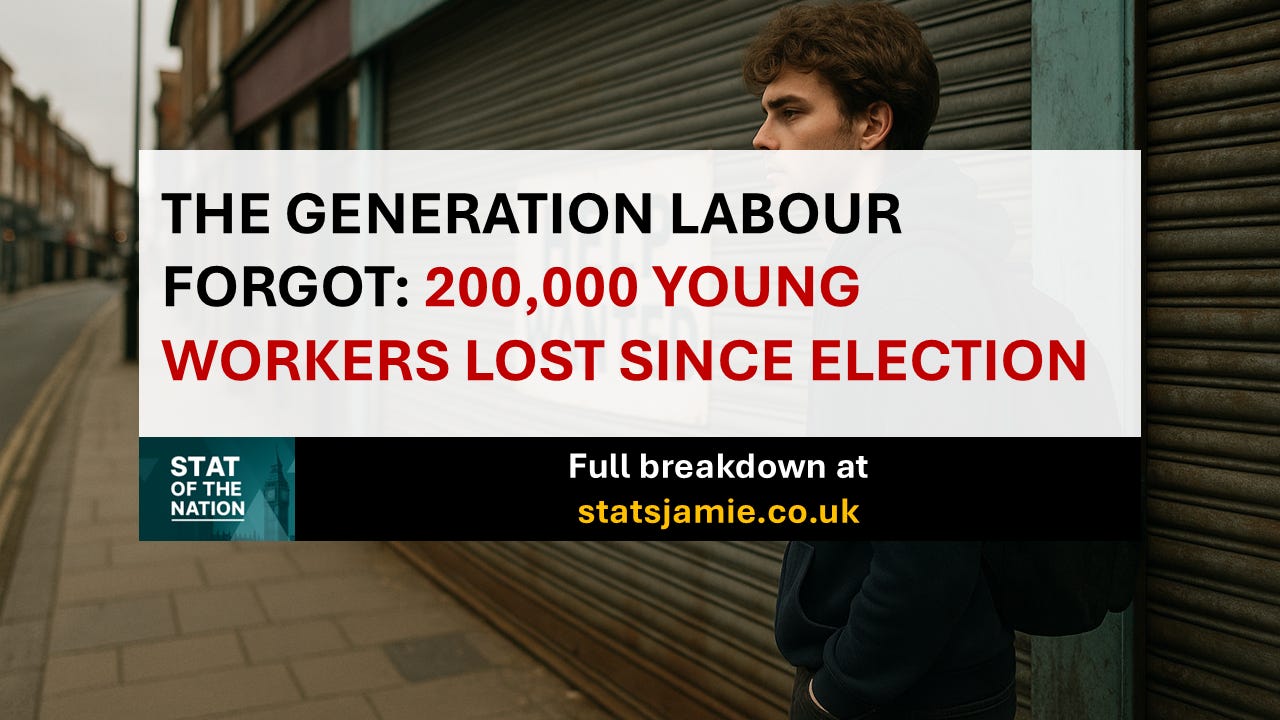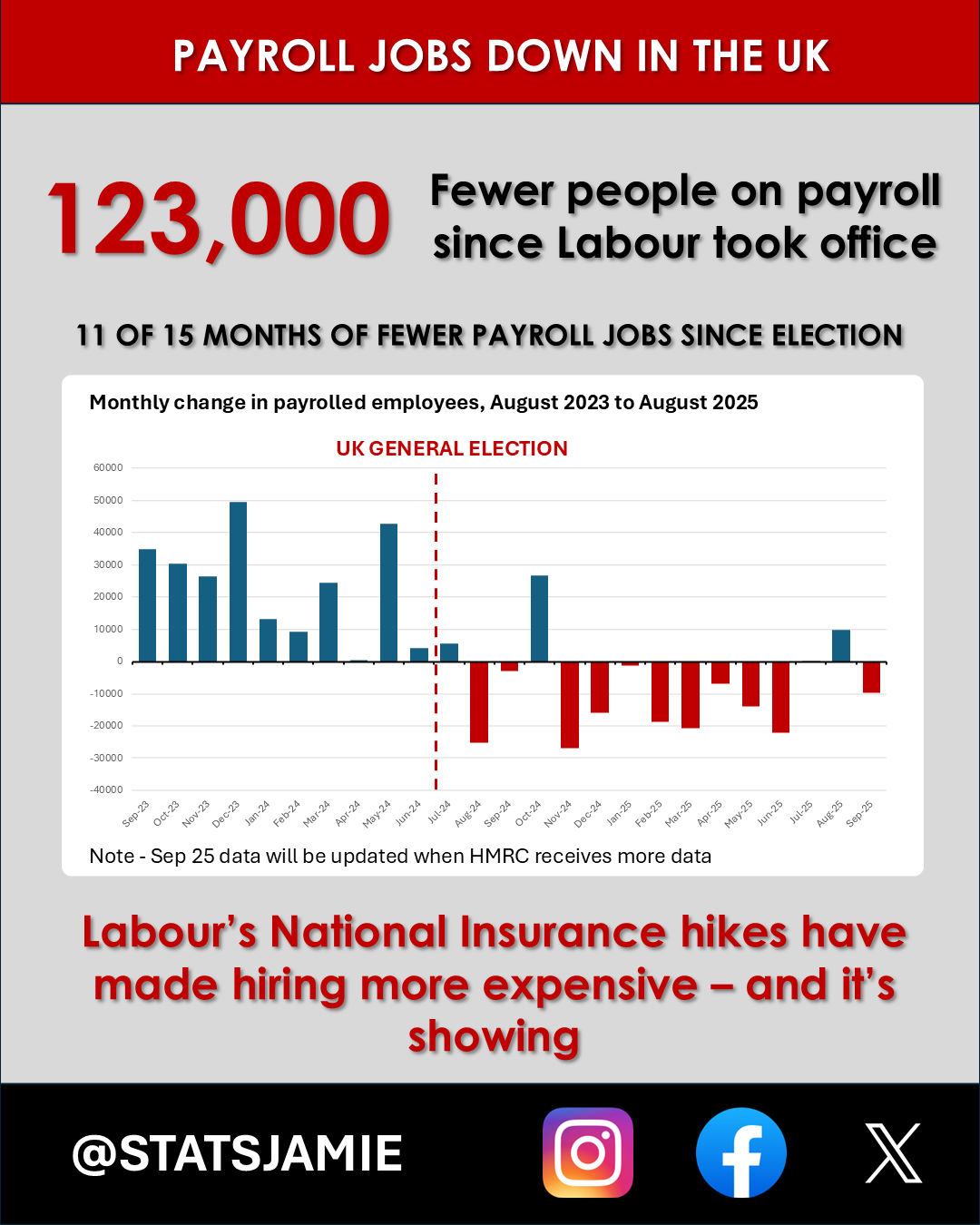The Generation Labour Forgot: 200,000 Young Workers Lost Since Election
ONS data show job losses in 11 of the last 15 months — with young workers hit hardest
🚨 The latest ONS payroll data reveal a clear generational divide.
Between June 2024 and September 2025, the number of people on payrolls fell by 123,000. That represents falls in 11 of the last 15 months — a steady erosion of employment since Labour took office. In addition, beneath the headline number, the data show that the drop came from younger workers.
The steepest decline was among those aged under 18 (–13.9%), followed by the 25–34 age group (–1.6%) and the 18–24 age group (–0.5%). In total, nearly 200,000 younger employees have disappeared from payrolls since Labour took office.
By contrast, employment rose slightly among mid-career workers (35–49 +0.9%) and grew fastest among those aged 65 and over (+4.6%) — a sign that older people are staying in or returning to work as living costs and taxes rise.
The UK unemployment rate now stands at 4.8%, its highest since early 2023.
🏭 Private-sector slowdown, public-sector growth
The most significant job losses since the election were in accommodation and food services (–75,800), retail (–72,700), manufacturing (–39,700), and information and communication (–39,500) — all core private-sector industries hit by higher costs and weaker spending.
By contrast, employment rose in health and social work (+69,900), education (+17,900), and public administration (+16,000).
In short, the private sector is tanking while the public sector keeps growing — meaning less tax revenue from productive activity to fund a public workforce that’s expanding anyway.
That imbalance can only be bridged by more government borrowing, which is exactly what’s happening.
💷 Public pay is racing ahead of private wages
The latest ONS figures show total pay (including bonuses) rising by 5.0 % across the whole economy in the year to August 2025.
Within that, private-sector pay grew by 4.8 %, while public-sector pay excluding financial services rose by 6.7 % — a gap of 1.9 percentage points.
That means the public sector is still outpacing the private economy, even as private payrolls shrink.
While part of the rise reflects earlier pay deals for health and education staff, the overall picture is one of a state rewarding itself faster than the economy can afford.
If that 1.9 percentage point gap were maintained for a full year, it would cost taxpayers around £5.5 billion — roughly 11 times what Labour hopes to raise from its controversial new farming tax.
🗺️ Regional picture
Every region of Great Britain recorded job losses between June 2024 and September 2025, while Northern Ireland was the only part of the UK to see growth.
Wales and London suffered the sharpest declines, both around 0.7%, while most other regions saw drops between 0.3% and 0.6%.
Northern Ireland remains the smallest economy and workforce in the UK, so even with its modest growth, it makes little difference to the national picture — Britain’s jobs decline remains broad-based.
👥 Who’s losing work
Younger workers are being hit hardest. The number of employees under 25 has fallen sharply in every region of Great Britain, with only Northern Ireland showing an increase.
The South East and London alone account for more than a quarter of all youth job losses, reflecting the downturn in hospitality, retail and other service sectors where young people are most concentrated.
Even regions with more industrial or rural economies — like Wales, the Midlands and Yorkshire — have seen under-25 employment fall by around 2%.
In short, no part of Great Britain has been spared.
💰 Wage policy and the youth squeeze
Part of the pressure on younger employment comes from rising wage floors.
The National Living Wage rose from £11.44 to £12.21 an hour in April 2025, while the minimum wage for 18–20 year olds jumped from £8.60 to £10.00, and for under-18s and apprentices from £6.40 to £7.55.
That’s a 6.7% rise for those 21 and over — but 16–18% increases for younger workers.
So while it may have seemed like a good-news story — pushing up the minimum wage more in both absolute and percentage terms for those aged up to 20 than those older — it has created an unintended consequence.
Younger staff are still cheaper to employ, but with smaller pay gaps and less experience, the incentive to hire them has diminished sharply.
Combined with Labour’s higher National Insurance costs and weak demand in hospitality and retail, it’s no surprise that under-25 employment is falling across every region of Great Britain.
⚖️ The long shadow of youth joblessness
The UK already has around 948,000 young people classed as NEET — Not in Education, Employment or Training. With payroll data now showing job losses among the under-25s across every region, that number is likely to climb further as opportunities for young workers dry up.
But this isn’t just a short-term setback. Falling out of work early in life can shape everything that follows — from earnings and skills to confidence, health and wellbeing. Those who start their adult lives without stable work often earn less for decades, struggle to build savings or buy a home, and face worse health outcomes later on.
The longer young people stay detached from work, the harder it becomes to reconnect them, and the country loses not only their potential, but the productivity and innovation they could have brought.
If Britain wants genuine renewal, it has to start with work. And right now, too many young people are being left behind before they’ve even begun.
✍️ Jamie Jenkins
Stat of the Nation exists to cut through the spin and show the numbers as they are.
If you value clear, fact-driven analysis — please share this roundup with others. And hit subscribe below to get the stats first, every week.
📲 Follow me here for more daily updates:



